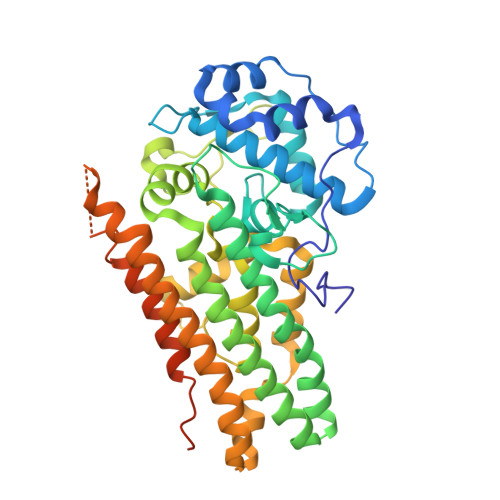Conformational Plasticity in Human Heme-Based Dioxygenases.
Pham, K.N., Lewis-Ballester, A., Yeh, S.R.(2021) J Am Chem Soc 143: 1836-1845
- PubMed: 33373218
- DOI: https://doi.org/10.1021/jacs.0c09970
- Primary Citation of Related Structures:
6UBP, 6UD5 - PubMed Abstract:
Human indoleamine 2,3-dioxygenase 1 (hIDO1) and human tryptophan dioxygenase (hTDO) are two important heme proteins that degrade the essential amino acid, l-tryptophan (Trp), along the kynurenine pathway. The two enzymes share a similar active site structure and an analogous catalytic mechanism, but they exhibit a variety of distinct functional properties. Here we used carbon monoxide (CO) as a structural probe to interrogate how the functionalities of the two enzymes are encoded in their structures. With X-ray crystallography, we detected an unexpected photochemical intermediate trapped in a crystal of the hIDO1-CO-Trp complex, where CO is photolyzed from the heme iron by X-rays at cryogenic temperatures (100 K). The CO photolysis triggers a large-scale migration of the substrate Trp, as well as the photolyzed CO, from the active site to a temporary binding site, Sa*. It is accompanied by a large conformational change to an active site loop, JK-Loop C , despite the severely restricted protein motion under the frozen conditions, which highlights the remarkable conformational plasticity of the hIDO1 protein. Comparative studies of a crystal of the hTDO-CO-Trp complex show that CO and Trp remain bound in the active site under comparable X-ray illumination, indicating a much more rigid protein architecture. The data offer important new insights into the structure and function relationships of the heme-based dioxygenases and provide new guidelines for structure-based design of inhibitors targeting them.
Organizational Affiliation:
Department of Physiology and Biophysics, Albert Einstein College of Medicine, The Bronx, New York 10461, United States.
















